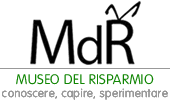
Financial education, sustainability, and youth form a trio that has always been close to the heart of the Museum of Saving.
The gaps in financial education in our country remain significant. Despite some progress, there is still much ground to cover. Discussing money with adults is complicated due to factors like feelings of inadequacy and, at times, shame. This makes it difficult to involve them in targeted training activities, whereas it seems easier to approach the topic through parallel activities such as book presentations, roundtable discussions, or meetings with specialists focused on specific topics.
However, financial literacy is essential to create a bridge connecting young people to the future of society. For this reason, the Museum has always worked to promote financial education among new generations through workshops aimed at schools of all levels and dedicated events. Learning to manage financial resources also teaches us to adopt a proper approach to environmental resources.
The S.A.V.E. Virtual Tour project, designed for primary and secondary school students, is dedicated to this aspect. Let us explore how adequate financial and economic preparation for young people can become the cornerstone for the global improvement of society.
Economic Sustainability and Environmental Sustainability
A sound understanding of the basic rules of economics enables individuals to make informed choices about saving and investing. Applying these concepts to “sustainability” helps us decide how to optimize the use of natural resources to design a more responsible, waste-free future.
As we know, both economic and natural resources are limited; therefore, it is crucial to manage them wisely for the healthy social and economic growth of a country.
Guiding young people through the core concepts of economic and environmental sustainability means equipping them with the tools they need to build a more sustainable world and future in a comprehensive way.
The Perspective of Youth
In 2021, the Museum of Saving conducted a study to understand how youngsters approached the theme of sustainability.
The findings revealed that the young participants, aged 13 to 18, already displayed a notable tendency to think in terms of sustainability, both environmental and economic.
As highlighted by the Museum’s Director and Curator, Giovanna Paladino, in the podcast “Mica solo parole“, “The new generations will bear many responsibilities, but we can already say they are proving more virtuous than previous ones.”
The Commitment of the New Generations
Young people are eager to actively contribute to building a sustainable future—their future—and they believe they can make a difference by adopting proper daily habits. At the same time, they assign significant responsibility to both politics and the current adult generation, which, in their view, have not done enough.
The concrete commitment of youth is also evident in numerous global initiatives, such as Youth4Climate. Launched under the guidance of the United Nations Development Programme (UNDP) and the Italian Government, this initiative supports youth-led solutions to address today’s environmental, climate, financial, and inclusion challenges.
In a consumer-driven society like ours, having the right knowledge and a long-term vision helps people make more thoughtful decisions. Educating young people on the fundamentals of finance, economic sustainability, and environmental sustainability is vital to start building a better tomorrow today—one that ensures well-being for all.
The Museum of Saving has always created educational content and projects for children and youth on the topics of sustainability and financial education.
Visit our website and follow us on social media to learn about all the activities and events designed for youth and families in advance!
